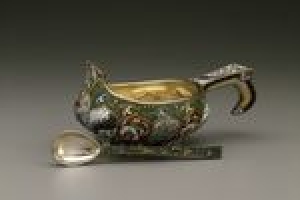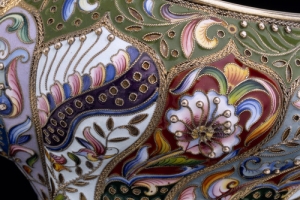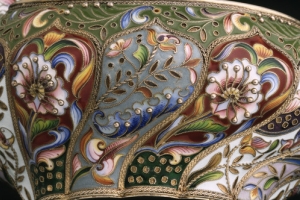KOVSH
Creator(s): Maria Semenova (Firm)
Currently in storage
About this object
Maria Semenova was an accomplished enameller known for her innovations with traditional Russian ornaments, such as this "kovsh," or drinking vessel and its matching spoon (15.91.2). She took over her father's workshop upon his death in 1896 and sucessfully ran the business until 1904.
The shape and color scheme demonstrate the influence of Art nouveau design. Although the basic silhouette does not deviate from the typical pattern, the normally straight embossed lobes here have softened and sway to one side in a manner recalling the furniture of Vallin or van de Velde. Instead of the typical (or perhaps earlier) pastel palette, this piece utilizes striking contrasts made between tertiary colors (deep khaki greens, burgundy red, pea green, and pale blue) rendered in opaque enamels. The surface of the areas of painted and cloisonné enamel has been enlivened with the application of twisted wires and granulation (tiny beads of gilded silver) interspersed with voided cells left entirely empty. The floral forms set within the lobes no longer bear close resemblance to blossoms seen in Usol'sk enamels, but appear to resemble a range of Eastern sources including carnation forms taken from Japanese graphics or textiles and the fine, trailing vines of Mughal manuscript ornament. The top of the flat handle is ornamented with the same pattern that appears on the back of the matching spoon (15.91.2). A flowering vine with flower petals painted with shaded enamels is set against a pale blue background. Above this appears to be an entirely abstract decorative form based on flowers or plants. A band of dark transparent enamel is relieved by circular voided cells. A row of petal-like forms seems to grow out of the band and sprout thin buds made of embedded wire topped by granulation. On the back of the handle a multicolored flower in shaded enamels ornamented with granulation is set against a background of deep burgundy, almost dark brick-colored enamel. The interior of the kovsh is ornamented, lightly buffed silver gilt.
- Object name:
- KOVSH
- Made from:
- Silver gilt -- enamel
- Made in:
- Moscow, Russia
- Date made:
- c. 1904
- Size:
- 18.4 cm (7 1/4 in.)
Detailed information for this item
- Catalog number:
- 15.91.1
- Class:
- ENAMEL
- Signature marks:
- silver standard; assayer's mark 84 [kokoshnik left] [Cyrillic] IL Struck on underside of kovsh. The three marks are contained within an oval. These so-called "doubles" (joined marks on a single poinçon) were introduced in the Assay Charter of 1882. This particular version (with kokoshnik and assayer's initials) was introduced in late 1898. The initials are those of Moscow assayer Ivan Sergeevich Lebedkin (active late 1898-1914). silver standard; assayer's mark 84 [kokoshnik left] [Cyrillic] IL Struck on underside of handle near pale blue. The three marks are contained within an oval. These so-called "doubles" (joined marks on a single poinçon) were introduced in the Assay Charter of 1882. This particular version (with kokoshnik and assayer's initials) was introduced in late 1898. The initials are those of Moscow assayer Ivan Sergeevich Lebedkin (active late 1898-1914). maker's mark [Cyrillic] MS Struck on underside of kovsh. The letters are set within an oval frame. Initials are those of the firm owner, Maria Semenova. maker's mark [Cyrillic] MS Struck on underside of handle. The letters are set within an oval frame. The mark is partially effaced by the assayer's marks. Initials are those of the firm owner, Maria Semenova. scratch mark C 1587 On underside of kovsh, below hallmarks. This might be an inventory number. If the writer was using Latin letters, it should be read as "S 1587"
- Credit line:
- Bequest of Marjorie Merriweather Post, 1973



